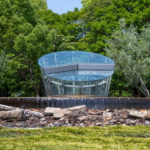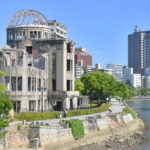Monument to Typhoon Victims from Kyoto University Atomic-bomb Disaster Research Team: Hiroshima Struck by Makurazaki Typhoon after the Atomic Bombing
Located about 30 kilometers west on National Route 2 from the center of Hiroshima City, the Miyahama Onsen area (Hatsukaichi City, Hiroshima Prefecture) is a popular hot spring resort overlooking the Seto Inland Sea. Yoneyama Park, which is located in the Miyahama Onsen area, is home to the Monument to Typhoon Victims from Kyoto University Atomic-bomb Disaster Research Team. This monument was built as a memorial to those who were killed by the massive debris flows caused by the Makurazaki Typhoon that hit the area on September 17, 1945. Among those who lost their lives were 11 members of the Kyoto University research team visiting Hiroshima to investigate the health hazards faced by A-bomb survivors at the request of the Army.
Those who had barely survived the devastation of the atomic bombing of Hiroshima experienced the catastrophe caused by the typhoon about one month later—it was a double disaster for them. This monument is not a memorial to those who died in the atomic bombing itself, but let us introduce it as a cenotaph related to the atomic bombing.
(Reported by Staff, Peace Promotion Project Team, Hiroshima Prefecture)
.png)
.png)
Monument to Typhoon Victims from Kyoto University Atomic-bomb Disaster Research Team, located at Yoneyama Park in Miyahama Onsen, Hatsukaichi City, Hiroshima
1 About Makurazaki Typhoon
A typhoon made landfall near the town of Makurazaki (present-day Makurazaki City, Kagoshima Prefecture) in southern Kyushu at around 2:35 p.m. on September 17, 1945, moved across the Kyushu region, struck Cape Sada (Ehime Prefecture), the Iyo Nada (Ehime Prefecture) and Hiroshima, and ravaged Yonago (Tottori Prefecture) and Matsue (Shimane Prefecture). Then on the morning of September 18, the typhoon passed the Noto Peninsula from the west into the Japan Sea passed north of Niigata and then made landfall again in the Tohoku region , moving across the region into the Pacific Ocean. Heavy rainfall of 57.1 mm was recorded for one hour from 9:07 p.m. to 10:07 p.m. on September 17. The worst affected areas were Hiroshima City and Kure City and their surrounding areas. The total death toll in Hiroshima Prefecture was 2,012. The typhoon caused massive debris flows, which moved into the Maruishi River in the village of Ono (present-day Ono-cho, Hatsukaichi City, Hiroshima), hitting the Ono Army Hospital, which was located near the lower part of the river.
2 Background Information on Monument to Typhoon Victims from Kyoto University Atomic-bomb Disaster Research Team
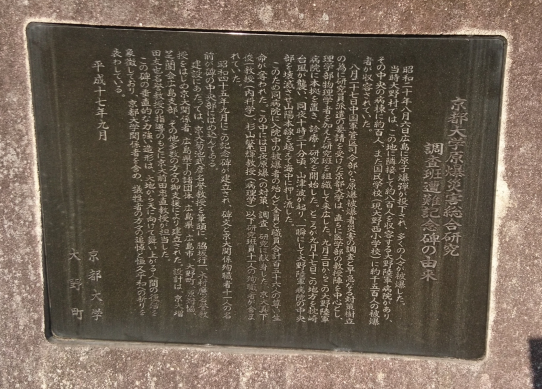
Back then, Odate in the village of Ono (the present-day Miyahama Onsen, Hatsukaichi City) was home to the Ono Army Hospital, which had a capacity of about 800 beds. About 100 A-bomb survivors were being treated in the central ward of the hospital and about 1,500 A-bomb survivors were being treated in the nearby national school (the present-day Ono-nishi Elementary School), which was operated as a branch of the army hospital then.
On August 27, 1945, Kyoto University received a request from the Chugoku Regional Military Headquarters to send researchers to investigate health hazards faced by atomic bomb survivors in Hiroshima and to take immediate countermeasures. The University immediately organized a research team consisting of researchers from the medical school, including some professors as well as some physicists from the faculty of science, and sent them to Hiroshima. On September 3, based at the Ono Army Hospital, the team began to provide medical care and conduct investigations. On September 17, the Makurazaki Typhoon hit this area. At around 10:30 p.m. on that day, the typhoon caused debris flows, instantly devastating the central ward of the army hospital and sweeping it over the Sanyo Main Line into the sea.
Due to the debris flows, a total of 156 people lost their lives. They included almost all the A-bomb survivors being treated at the army hospital, hospital staff and 11 members of the research team, who devoted themselves day and night to implementing countermeasures, investigations and research.
Erected in September 1970, this monument bears, in its center, an inscription and the names of the 11 members of the Kyoto University research team who lost their lives to the debris flows. The monument is made up of four triangular concrete walls that rise up from all four sides. As the inscription says, this design “symbolizes human souls soaring from the soil to the heavens and represents a memorial to the disaster victims, including the 11 people from Kyoto University, and a prayer for lasting peace.” In front of the monument, a memorial service is held every year on a holiday around September 17.
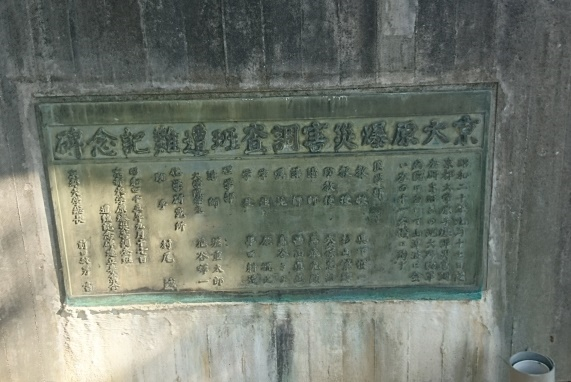
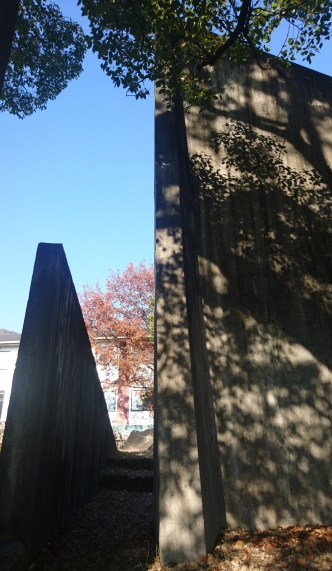
References:
“Makurazaki Typhoon in September 1945” Hiroshima Prefectural Government
Inscription on the Monument to Typhoon Victims from Kyoto University Atomic-bomb Disaster Research Team
Tags associated with this article



